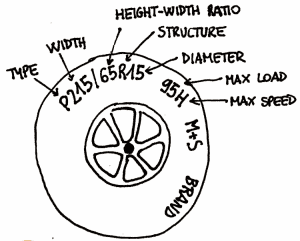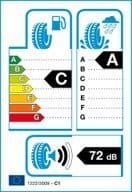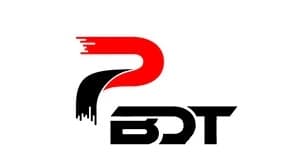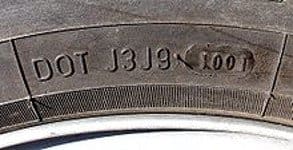Tire code explained: check the size of your tires
The meaning of tire code explained.
We’ve already written a number of articles related to tyre behaviour and their performances (see here). This time we want to focus on a more real problem: the tire code. How many times have you tried to understand the meaning of the tire code visibile on the side? In this article, we’ll get a chance to explain the fundamental meaning of the tire code.
Physical characteristics and dimensions in a tire. The basic characteristics of a tire, usually written with hot-stamped code markings on the side of the tire, are:
- Performance characteristics
- Construction features
- Date of production

We indicate:
- T: Tire type (P = passenger, that is, for cars) not mandatory in Europe
- l: Maximum tire width, under pressure and load conditions defined by the standards, this measurement is expressed in millimeters, in rare cases in inches and in the past it was also expressed with a literal system, in some cases it is possible to switch between a system other
- hl: Ratio, expressed as a percentage, between shoulder height and section width (therefore multiplying l by h gives the height of the shoulder). The tire is defined as low when this ratio is less than 80, super-low when it is less than 45. The smaller this number, the better the grip at the expense of comfort. If omitted, it is to be considered 80.
- St: Structure concerning the arrangement of the plies and indicated with a letter, it can be radial “R” (“ZR” if the tire exceeds 240 km / h) or diagonal (also called bias belted or conventional or crossed plies) ” B “or” – “
- d: Rim diameter (usually in inches, more rarely in millimeters)
- cM: maximum permissible load. It is a reference index to the limit mass (in kg) allowed on the single wheel. By law, tires with a capacity equal to or greater than the values transcribed in the registration certificate must be fitted. The actual values referred to the indices are:
- 0 = 45 kg
- 10 = 60 kg
- 28 = 100 kg
- 42 = 150 kg
- 52 = 200 kg
- 66 = 300 kg
- 76 = 400 kg
- 84 = 500 kg
- 90 = 600 kg
- 96 = 710 kg
- 100 = 800 kg
- 108 = 1000 kg
- 122 = 1500 kg
- 132 = 2000 kg
- 146 = 3000 kg
- 164 = 5000 kg
- 188 = 10000 kg
- 212 = 20000 kg
- 268 = 100000 kg
- 279 = 136000 kg
- vM: Maximum permissible speed expressed by a letter, by law tires must be fitted with a capacity equal to or greater than the values transcribed in the registration certificate, more precisely:
- A1: 5 km/h
- A8: 40 km/h
- B: 50 km/h
- J: 100 km/h
- P: 150 km/h
- U: 200 km/h
- Y: 300 km/h
There are also some particular indices, which do not only indicate the speed or indicate it in a different way
- VR: over 210 km / h (maximum is not specified)
- ZR: over 240 km / h (maximum is not specified)
- ZR + W: over 240 km / h (maximum speed less than 270 km / h)
- ZR + Y: over 240 km / h (maximum speed less than 300 km / h)
- ZR + load index + W: over 240 km / h (top speed above 300 km / h)
(all tires exceeding 240 km / h must have the letter Z indicated in the indication of the dimensional designation of the tire eg: 255/30 ZR 19 94W)
- Sca: Attitude to use without inner tube, with the wording “TL” or “Tubeless”
- D: expressed as xxyy, where xx is the week and yy the year of construction.
- N: Name of the tire, in the form of a registered trademark.
- M + S: commonly defined winter tires (Mud and Snow)
XL: heavier load (usually stiffer shoulder)
An example of a real membership could be:
P235 / 45R17 97W
interpretable as:
- P indicates that it is a passenger car tire (“P” of passenger).
- 235 – the width is 235 mm.
- 45 – the ratio of height to width is 45% – consequently the height is 105.75 mm.
- R – this is a radial tire.
- 17 – for 17-inch wheels.
- 97 – the maximum permissible weight, in this case of 730 kg.
- W – for a maximum speed of 270 km/h (167 mph).
The production date is identified by three digits of which the first two indicate the week and the last one thousandth of the year of manufacture, sometimes a four-digit code is used where the last two indicate the year of production, example 4792 (week 47, year 1992) or 4709 (week 47, year 2009)
Approval codes
Depending on the country or continent, the tire must follow certain homologation laws and bear the wording of the same on the tire, generally given that tire manufacturers work internationally, multiple approvals can be reported on the same tire.
The main terms are:
What is a DOT of a tire?
DOT of a tire explained.
- DOT (Department of Transportation) American approval with attached tire production date, 4-digit date, the first two indicate the week and the other two refer to the year of production
- ECE-UN / EU and Directive 92/23 / EEC are the European approvals
- E1 indicates the approval and the country that issued it, approval is a mandatory requirement.
These approvals also provide for the use of additional abbreviations to identify the characteristics of use of the tire or particular characteristics / treatments, such as:
- MST (Multi Service Tire) indicates p special tires suitable for mixed road and off-road use.
- NHS (Not for Highway Service) indicates tires not for road use, as for competition use only.
- P (passenger car) indicates a tire for exclusive use for cars, this abbreviation is placed before the tire size
- RETREAD or 108 R wording for retreaded tires, where the original (European) type-approval mark is canceled, and replaced by a mark that refers to the UN-ECE Regulation no. 108
- Snowflake symbol represents a mountain with a snowflake inside, this symbol identifies winter tires approved according to American standards.
Tire label explained. How to find consumption, wet grip and rolling noise of a tire.

The measured, evaluated and shown parameters are:
- Consumption (rolling resistance), where the rolling resistance is assessed, as the greater the rolling resistance and the higher the fuel consumption, which changes not only because of the physical characteristics of the tire, but also with the pressure of the same.
- Wet grip, this evaluation is carried out by braking a car on a wet surface Test performed by a standard vehicle equipped with ABS, which must go from 80 to 20 km/h, water layer between 0.5 and 1.5 mm, with a temperature between 2 and 20°C for winter tires and between 5 and 35°C for summer tires.
- External rolling noise, represents the noise produced by the tire while driving outside the vehicle and displays the value in dB and through a loudspeaker with lots of sound bars, which represent:
- 3 black bars = tire compliant with current regulations
- 2 black bars = average noisy tire, between the future limit and 3 dB below
- 1 black bar = low noise tire, over 3 dB below the future limit.



